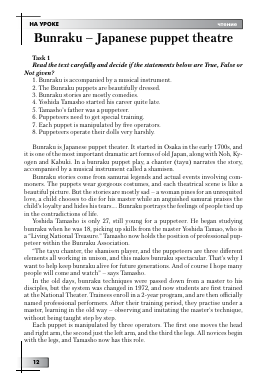HA yPOKE MTeHM
Bunraku - Japanese puppet theatre
Task 1
Read the text carefully and decide if the statements below are True, False or Not given?
1. Bunraku is accompanied by a musical instrument.
2. The Bunraku puppets are beautifully dressed.
3. Bunraku stories are mostly comedies.
4. Yoshida Tamasho started his career quite late.
5. Tamasho's father was a puppeteer.
6. Puppeteers need to get special training.
7. Each puppet is manipulated by five operators.
8. Puppeteers operate their dolls very harshly.
Bunraku is Japanese puppet theater. It started in Osaka in the early 1700s, and it is one of the most important dramatic art forms of old Japan, along with Noh, Ky-ogen and Kabuki. In a bunraku puppet play, a chanter (tayu) narrates the story, accompanied by a musical instrument called a shamisen.
Bunraku stories come from samurai legends and actual events involving commoners. The puppets wear gorgeous costumes, and each theatrical scene is like a beautiful picture. But the stories are mostly sad - a woman pines for an unrequited love, a child chooses to die for his master while an anguished samurai praises the child's loyalty and hides his tears.... Bunraku portrays the feelings of people tied up in the contradictions of life.
Yoshida Tamasho is only 27, still young for a puppeteer. He began studying bunraku when he was 18, picking up skills from the master Yoshida Tamao, who is a "Living National Treasure." Tamasho now holds the position of professional puppeteer within the Bunraku Association.
"The tayu chanter, the shamisen player, and the puppeteers are three different elements all working in unison, and this makes bunraku spectacular. That's why I want to help keep bunraku alive for future generations. And of course I hope many people will come and watch" - says Tamasho.
In the old days, bunraku techniques were passed down from a master to his disciples, but the system was changed in 1972, and now students are first trained at the National Theater. Trainees enroll in a 2-year program, and are then officially named professional performers. After their training period, they practise under a master, learning in the old way - observing and imitating the master's technique, without being taught step by step.
Each puppet is manipulated by three operators. The first one moves the head and right arm, the second just the left arm, and the third the legs. All novices begin with the legs, and Tamasho now has this role.
HA yPOKE
"The two puppeteers operating the left arm and the feet sense the subtle movements of the head and the right shoulder, then follow along, working as a single unit. This makes the puppet move smoothly, so smoothly it sometimes appears more human than a real person. The master manipulates the head and right arm, and the other two puppeteers feel, through the puppet, as if they are part of him. It's an experience that keeps teaching me more."
Tamasho says he has to keep preparing himself mentally every day. "I don't know when, but one day I'll take on something more important than the legs. I'm doing what I can to get ready, so when that day comes I won't get flustered."
The picture shows a scene from the puppet play Sugawara Denju Te-narai Kag-ami, performed at the National Theater in May 2002. The two principal puppeteers shown here are Yoshida Bunjaku (left) and Yoshida Tamao, who is Tamasho's teacher.
Task 2
Match the beginnings and endings of the sentences. Try not to consult the text.
1. In a bunraku puppet play, a chanter (tayu) narrates the story, accompanied by...
2. The tayu chanter, the shamisen player, and the puppeteers...
3. I don't know when, but one day I'll take on...
4. Bunraku stories come from samurai legends...
5. In the old days, bunraku techniques were passed down from a master to his disciples...
6. This makes the puppet move smoothly...
a. and actual events involving commoners.
b. a musical instrument called a shamisen.
НА УРОКЕ
c. are three different elements all working in unison, and this makes bunraku spectacular.
d. so smoothly it sometimes appears more human than a real person.
e. something more important than the legs.
f. but the system was changed in 1972, and now students are first trained at the National Theater.
Task 3
Develop the following ideas using the information from the text.
1. Tamasho has to keep preparing himself mentally every day.
2. Bunraku portrays the feelings of people tied up in the contradictions of life.
3. Sometimes a puppet can appear more human than a real person. Task 4
Answer the following questions.
1. What type of theatre is bunraku?
2. How did puppeteers study bunraku techniques in the old days?
3. How did the system change in 1972?
4. How do puppeteers manipulate their dolls?
5. What do you know now about bunraku plays? Culture corner
What do you know about the art of traditional Japanese theatre: Noh, Kyogen and Kabuki? Pick one of them and using a reliable information source, get ready with a colorful slide presentation devoted to one of them. Keys: Task 1
1 - T, 2 - T, 3 - F, 4 - F, 5 - NG, 6 - T, 7 - F, 8 - F. Task 2
1 - b, 2 - c, 3 - f, 4 - a, 5 - g, 6 - d.
Source: http://web-japan.org/nipponia/nipponia22/en/feature/feature07.html
Е.А. Ручкина
Сведения об авторе: Ручкина Елизавета Алексеевна, студентка кафедры японского языка, Институт иностранных языков, Московский городской педагогический университет. E-mail: e.ruchkina@mail.ru
Ключевые слова:puppet theatre, Japanese theatre, Japanese traditions.
,4 ]
Для дальнейшего прочтения статьи необходимо приобрести полный текст. Статьи высылаются в формате PDF на указанную при оплате почту. Время доставки составляет менее 10 минут. Стоимость одной статьи — 150 рублей.
